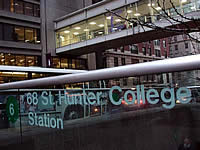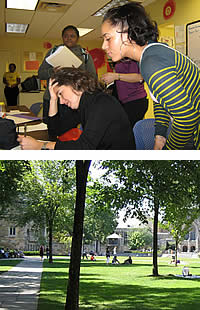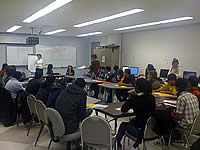
by Kathleen Cushman
BUSHWICK, NY—On this bitter late-December day, Bushwick Campus High School looms suddenly large against the low-built homes, warehouses, and boarded-over storefronts lining the potholed streets of this long-neglected Brooklyn neighborhood. Once, such grand-scale public high schools stood as a symbol of hope and progress for an immigrant nation, and now New York is pushing to restore their power to inspire.
Inside in the warmth, the cafeteria comes suddenly alive with students from the four small high schools that share this building. Vacation is only a few days away, and the late-morning chatter is giddy and anticipatory as students move through, slinging their backpacks. But they are not just hanging out at lunchtime; they are clearly headed somewhere else that matters.
Like a brightly painted magnet, a door in the rear of the cafeteria marked “Student Success Center” is drawing a steady stream of kids into a suite of rooms that fairly crackles with energy and purpose. At every computer station along its walls, two or three students gather, eyes fixed on the screen as one of them punches information into the online Common Application for four-year college admissions. It’s not the winter break that these students are counting down to: College application deadlines are coming up on them fast—and they need help.
And they know just where to turn for it. Tevon, a lanky senior with close-braided hair, stands near a central conference table, intensely focused on another senior who has asked him to read her personal statement. “This is a strong introduction—you used a strong quote,” he encourages her. “Now you got to emphasize your characteristics, and say why you are interested in this college. You have everything else you need.”
As Tevon wraps up his advice, someone else catches his sleeve: What about this college, which doesn’t take the Common App? Then another student, almost frantic with worry: Sending SAT score reports costs $9.50 for each college—how can she afford to apply to five? Tevon’s answers come, swift and assured. Not yet out of high school himself, he knows how to get his peers past these potholes.
Too much to tackle alone
Tevon is one of eight Youth Leaders at Bushwick’s Student Success Center (SSC), the oldest of three such youth-to-youth college access programs in New York City. The Student Success Centers, each a collaboration between a community-based organization and a set of high schools, are organized by the Urban Youth Collaborative and supported by Homebase (a small intermediary operating out of the Center for Human Environments at The CUNY Graduate Center). These groundbreaking programs seize by the horns the dilemma that blocks college access and success.
Too many students and too few college counselors make for painfully inadequate structure and support for students in the college search, planning, and application process, as the Consortium on Chicago School Research reported in its 2008 study of Chicago high schools, From High School to the Future: Potholes on the Road to College.
Surveys conducted by students in the Urban Youth Collaborative bore out that finding in New York. Although 90 percent of high school students said they aspired to attend college, two thirds of those in large schools and half of those in small schools responded that they were “never,” “rarely,” or “only sometimes” able to get help at school when they had questions about college. Especially if they would be the first generation in their family to attend college, these students are often left to navigate the college path—and its potholes—on their own.
Building a college culture
Even though they may want a college degree, many low-income students do not see it as a realistic option. “I honestly didn’t think a lot about college before this,” said Brittney, who signed up as a Youth Leader in February 2009 and is now a senior. “A lot of teachers look down on us, like we’re not going to go.”
To combat that mindset among their peers, the Youth Leaders go all out. “We’re like a bridge between students and the counselors and teachers,” said Patrick, an 11th-grader who started coming to the SSC as a sophomore and then trained as a Youth Leader. “We motivate those who are not motivated— helping them receive what most people don’t let them get. We say, ‘Go ahead, prove them wrong!’”
By now, the Bushwick Campus SSC has taken 280 students on 18 trips to visit a wide variety of colleges. They organize “college-culture events” like a SUNY vs. CUNY basketball game and a Gala College Prom reserved for students who complete their applications. And each spring, Youth Leaders fan out into classrooms around the building, giving ninth-to-eleventh graders explicit coaching on what they need in order to stay on the college path.
With its youth-friendly atmosphere and central location off the cafeteria, the Bushwick SSC has also fostered a sense of unity and common culture across the four very different small schools in the building. “This is the only place where all seniors on campus can come and talk to each other,” said Emilia Wiles, a Make the Road NY staffer, who directs the SSC. Aside from sports teams, no other campus-wide initiative consistently draws students together to develop leadership and nurture their potential.
New horizons bring big problems
 Reluctance to believe that they belong at college, however, is just the first obstacle these students must overcome. The logistical potholes that trip up low-income students show up in sharp relief as these Youth Leaders interact with their peers. For example, completing all the elements of a college application requires careful preparation: assembling resumes, writing effective personal essays, reaching out for the strongest possible recommendations.
Reluctance to believe that they belong at college, however, is just the first obstacle these students must overcome. The logistical potholes that trip up low-income students show up in sharp relief as these Youth Leaders interact with their peers. For example, completing all the elements of a college application requires careful preparation: assembling resumes, writing effective personal essays, reaching out for the strongest possible recommendations.
Even filling in family information often presents dilemmas. Working on her application at one of the computers, Amia, a senior who is applying to six colleges and hopes to study nursing, turns to Brittney to ask how she should describe her father’s employment, since he is on disability. “Just put his most recent occupation,” Brittney responds confidently. “You can tell about his disability in this other section, right here.”
Because of their huge student load, school guidance offices routinely steer low-income applicants toward a few public colleges with simple online applications. But SSC Youth Leaders encourage them to apply to many more places, and to strongly consider private as well as public institutions.
College visits help widen their horizons, said Patrick, a Youth Leader who accompanied a group to Boston campuses last year. “We ask them, ‘What kind of vibe do you receive? Is it inviting, is it embracing? How do you like the students, do you see diversity? Do you like the facilities?’” Finding the “best fit” for a student’s college years, research shows, has an enormous effect on persistence to the degree.
The Bushwick Campus SSC has already seen a huge increase in the numbers and variety of applications students submit, Emilia Wiles noted, and acceptances have gone way up, too. However, filling out private applications has its own logistical challenges.
“I don’t think I would have got my applications done anywhere but here,” said Ashley, who had just received an acceptance letter from Penn State. “With private colleges, you’ve got to do a whole separate application, and even after you press Submit, you have to send a lot of other envelopes.”
Figuring out how to pay for the whole college process also presents major potholes for low-income students. Application fees add up, and waivers are limited.  Sending SAT scores costs money each time. To apply for financial aid, families must fill out the government’s FAFSA forms—which means completing tax forms quickly and correctly—and private colleges often require an additional aid application. New York students must calculate whether their family income qualifies them for the state’s Educational Opportunity Programs (EOP, HEOP and SEEK), offering substantial help toward a degree. When private colleges offer financial aid packages, students must know how to compare and negotiate them. Researching and applying for outside scholarships is an additional chore. Finally, once an accepted student decides where to go, families must come up with a substantial cash deposit to hold a place at the school.
Sending SAT scores costs money each time. To apply for financial aid, families must fill out the government’s FAFSA forms—which means completing tax forms quickly and correctly—and private colleges often require an additional aid application. New York students must calculate whether their family income qualifies them for the state’s Educational Opportunity Programs (EOP, HEOP and SEEK), offering substantial help toward a degree. When private colleges offer financial aid packages, students must know how to compare and negotiate them. Researching and applying for outside scholarships is an additional chore. Finally, once an accepted student decides where to go, families must come up with a substantial cash deposit to hold a place at the school.
“Many people just assume that students can deal with this on their own,” said Lori Chajet, Homebase’s Director of Training and Program Development. “But it’s very challenging and complex, even more so for the most advanced students who are applying to numerous public and private schools. At the SSC, they get help and support. They start to feel like, ‘I’m not scared, I can do this.’”
Learning the ropes, together
 The Bushwick Campus SSC gives its Youth Leaders intensive training in the whole process, partly by shepherding them through their own applications during summer training sessions. Davante, who had applied to five schools by December, said, “I can do my apps at home by now.” To him, however, “The most satisfying thing is seeing other students succeed with me—we’re all doing this together.”
The Bushwick Campus SSC gives its Youth Leaders intensive training in the whole process, partly by shepherding them through their own applications during summer training sessions. Davante, who had applied to five schools by December, said, “I can do my apps at home by now.” To him, however, “The most satisfying thing is seeing other students succeed with me—we’re all doing this together.”
Just as important, the SSC helps provide professional development for guidance counselors in its four schools as trusting relationships grow. Impressed at how many students stay late after school to work on college applications at the center, some counselors on campus now see the program as integral to their own work. “Students are far more motivated by other students,” said Leia Petty, a counselor at the Academy of Environmental Learning, one of the campus’s small schools. As the college readiness center at her school gets better, she said, she will start calling on SSC as early as the ninth grade year.
Petty took on college advising for the first time this year—a job for which the city schools require no prior training—and looks frequently to SSC for help. Recently, Emilia Wiles took her along to a special training on financial aid, at Goddard Riverside'S OPTIONS program, which is an SSC partner. And the SSC will also offer trainings on various aspects of the application process to counselors at all the schools in the building.
Shaping a community
If New York City really wants to push higher education, Wiles declared, youth-to youth programs like SSC hold out the best hope. Before Bushwick’s SSC opened, only 10 percent of the senior class at one small school on the campus completed applications for private college—and only 30 percent of those won admission. The next year, working with SSC, almost 60 percent of seniors completed private-college applications, and 90 percent of those were accepted. Meanwhile, the number of applications to the City University of New York (CUNY) doubled, and they almost doubled for the state university (SUNY).
“There’s a new culture here,” said Wiles. “These Youth Leaders are intelligent and confident and coherent, and they translate the information so well to their peers. They have a bigger effect than most teachers on their peers! Students respond to them, they follow them.”
The culture change also seems to be spreading to the surrounding community. “People are coming here from outside the schools—high school graduates who want access to some sort of college help,” said Wiles. The center needs more computers and resources, she said. “And the city needs more centers, in different schools.” Indeed, Bushwick is just one of three thriving Student Success Centers in New York City, and the movement to establish more is growing.
Yari Mercado, whose job is to manage many administrative details at the SSC, offers her own special perspective on how the SSC is changing Bushwick. The mother of three young children, she herself attended Bushwick High School in the 1990s, then left, completed her GED, and went to a two-year college. Working for the nonprofit Make the Road NY, she helped fight to establish the SSC here.
“It’s a really good feeling to see kids flooding in,” Mercado said. “I’m proud—because now we’re going to see a high number of black and Latino students going to college.”
For more information on the Student Success Center Initiative contact: studentsuccessnyc@gmail.com.




